The endeavor to establish a Swedish cultural canon has been fraught with controversy. Beyond the fundamental disagreement over the very idea of a state-sanctioned canon, a committee member resigned in protest, claiming a deviation from the government’s directive. This has fueled the debate, highlighting the inherent complexities and sensitivities involved in defining a nation’s cultural heritage. Furthermore, public opinion is deeply divided on the content of such a canon, with diverse groups advocating for the inclusion of works representing their specific interests, while others champion the inclusion of contemporary cultural forms like hip-hop. The existing discord makes it almost certain that the proposed canon, due next year, will face widespread dissatisfaction. This dissatisfaction is not necessarily a reflection of the quality of the selected works, which remains unknown, but rather stems from a fundamental misunderstanding of how a cultural canon, rooted in and contributing to shared cultural references, is organically formed.
A cultural canon in a democratic society cannot be imposed top-down, unlike in previous eras when rote memorization of religious texts was expected. Instead, it emerges organically from the ground up, shaped by the collective tastes and preferences of the majority. This process is significantly influenced by educational institutions, which curate the songs sung and the books read in classrooms, thereby shaping the cultural landscape for future generations. This grassroots development ensures the canon reflects widespread cultural touchstones rather than the preferences of a select few or a specific political agenda. Attempting to force a canon upon a population will likely be met with resistance and will fail to achieve the intended goal of fostering a shared cultural understanding.
The current debate surrounding the Swedish cultural canon seems to misconstrue its very purpose. A canon’s objective isn’t to promote niche cultural expressions or special interests, nor is it to define what constitutes ”good” or ”important” culture. It’s not about fulfilling quotas or ticking boxes for representation. The task entrusted to Lars Trägårdh, the appointed investigator, isn’t about creating a canon from scratch. Rather, it’s about identifying and documenting the cultural touchstones that resonate with the majority of Sweden’s adult population. It’s akin to Ellen Key’s celebrated definition of education: ”what remains after we have forgotten everything we learned.” This suggests the focus should be on identifying widely recognized cultural references that persist in collective memory, irrespective of their origin or how they achieved that status.
In essence, Trägårdh’s task is to capture the shared cultural understanding that allows people to connect through common references. For instance, referencing a ”Fanny and Alexander” Christmas, alluding to Ulla Winblad’s profession, or mentioning a Strindberg novel evokes specific images and meanings within Swedish culture. While these examples might not resonate with every individual, the aim of a canon isn’t to achieve universal representation. Instead, it’s about broadening access to these prevailing cultural references, enabling wider participation in the collective cultural dialogue. These shared points of reference facilitate communication and understanding, fostering a sense of shared cultural heritage.
It’s important to recognize that these shared cultural references are not explicitly defined by any authority, despite some historical instances where certain works were promoted for ideological reasons. They emerge organically because a small fraction of all Swedish books, films, plays, and songs achieve widespread recognition, becoming ingrained in the collective consciousness. These works, by virtue of their enduring presence, constitute the cultural canon. This organic emergence contrasts with the current debate, where specific inclusions are being advocated for, suggesting a misunderstanding of how a canon naturally develops.
The controversy surrounding the Swedish cultural canon underscores the challenges inherent in defining and formalizing a nation’s cultural heritage. The disagreements and debates surrounding the project reveal the diverse and often conflicting perspectives on what constitutes essential Swedish culture. The anticipated dissatisfaction with the final proposal highlights the difficulty of capturing a nation’s cultural essence in a definitive list. Perhaps the most significant takeaway from this endeavor is the realization that a canon is not a static entity to be dictated but rather a dynamic reflection of a society’s evolving cultural landscape, constantly shaped by the collective experiences and preferences of its people.














